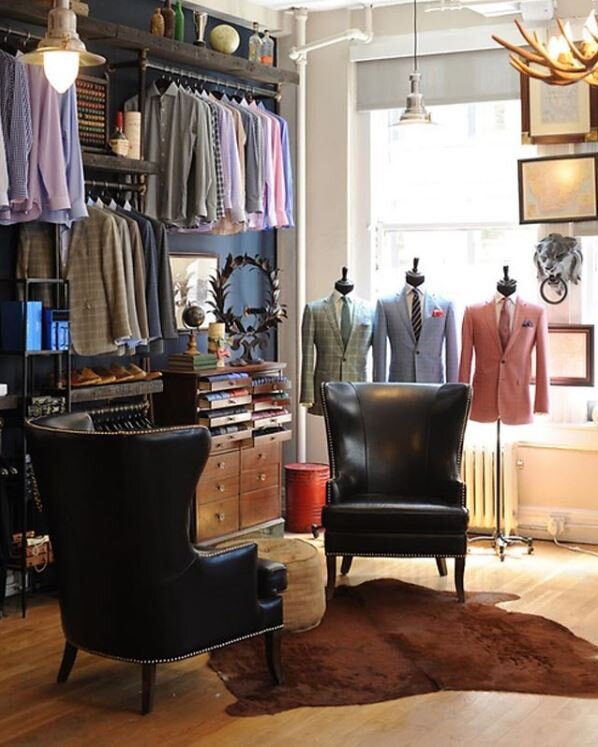Works Cited
“3D Body Scanning.” 3D-A-Porter, 3d-a-porter.com/services/3d-bodyscanning/.
“3D Scan for Customized Clothing.” Vitronic: the Machine Vision People, https://www.vitronic.com/industrial-%20and-logistics-automation/sectors/3d-body-scanner/3d-scan-for-customized-clothing.html.
“Acustom Apparel.” Acustom Apparel, www.acustom.com/.
“Alton Lane.” Alton Lane, 2019, www.altonlane.com/.
“Apparel.” Size Stream, 2019, sizestream.com/apparel/.
“Brioni.” Brioni, 2018, www.brioni.com/us.
“Can the Promise of Perfect Fit Disrupt Fashion?” Morgan Stanley, 29 Oct. 2018, www.morganstanley.com/ideas/3d-scanning-apparel.
“Fit3D.” Fit3D, 2018, www.fit3d.com/.
“Indochino.” Indochino, www.indochino.com/.
“La Fédération.” Fédération De La Haute Couture Et De La Mode, fhcm.paris/en/.
“Men’s Wearhouse.” Men’s Wearhouse, www.menswearhouse.com/mens-suits.
“Rigby & Peller: Lingerie Stylists London.” Rigby & Peller, www.rigbyandpeller.com/US.
“Savile Row Bespoke.” Savile Row Bespoke, www.savilerowbespoke.com/.
“Size Stream.” Size Stream, 2019, sizestream.com/.
“Studio Suits.” Studio Suits, 2019, www.studiosuits.com/.
“Styku.” Styku, 2017, www.styku.com/.
“The Future of Fashion: From Design to Merchandising, How Tech Is Reshaping The Industry.” Research Brieds, CB Insights, 27 Feb. 2018, www.cbinsights.com/research/ fashiontech-future-trends/.
Anderson, Fiona, et al. “Scientific Analysis Reveals Major Differences in the Breast Size of Women in Different Countries.” The Journal of Female Health Sciences, pp. 268-83.
Anderson, Fiona. “Fashioning the Gentleman: A Study of Henry Poole and Co., Savile Row Tailors 1861–1900.” Fashion Theory, vol. 4, no. 4, 2000, pp. 405-26, doi:10.2752/136270400779108663.
ASTM D5585-11e1. “Standard Tables of Body Measurements for Adult Female Misses Figure Type, Size Range 00–20.” ASTM International, Compass, 2012, compass.astm.org/EDIT/html_annot.cgi?D5585+11e1.
Babcock, Gregory. “How to Dress for Your Body Type.” Complex, 26 June 2017, www.complex.com/style/2015/04/how-to-dress-for-your-body-type-men/.
Barry, Ben. “What Happens When Men Don’t Conform to Masculine Clothing Norms at Work?” Harvard Business Review, 5 Sept. 2017, hbr.org/2017/08/what-happens-when
men-dont-conform-to-masculine-clothing-norms-at-work.
Bauman, Zygmunt. Consuming Life. Polity Press, 2008, pp. 25-51.
Blackman, Cally. 100 Years of Menswear. Laurence King, 2009.
BOF team. “Finding the Luxury in Mass Customisation.” The Business of Fashion, 22 June 2011, www.businessoffashion.com/articles/fashion-tech/fashion-2-0-finding-the-luxury-in-mass-customisation.
---. “When It Comes to Technology, Fashion Is Still a Laggard.” The Business of Fashion, 28 Sept. 2018, www.businessoffashion.com/articles/professional/when-it-comes-to-technology-fashion-is-still-a-laggard.
Bohm, David. On Creativity. Edited by Lee Nichol, Routledge, 2011, pp. 33-49.
Breward, Christopher. The Hidden Consumer: Masculinity, Fashion and City Life, 1860–1914. Manchester University Press, 1999.
Breward, Christopher, and Caroline Evans, editors. Fashion and Modernity. Berg, 2005.
Brown, Patty, and Janett Rice. Ready-to-Wear Apparel Analysis. Pearson, 2014.
Bubonia, Janace E. Apparel Production Terms and Processes. Fairchild Books, 2017.
Charpy, Manuel. “Adjustments: Bodies and Clothing in Standard Industrial Sizes During the 19th Century.” Special Issue in English, special issue of Modes Pratiques: revue d’histoire du vêtement et de la mode, 2018, pp. 181-213.
Chitrakorn, Kati. “Six Fashion Careers of the Future.” The Business of Fashion, 14 Nov. 2016, www.businessoffashion.com/articles/careers/six-fashion-careers-of-the-future.
Chodosh, Sara. “‘Fat but Fit’ Is Absolutely Possible.” Popular Science, 29 May 2017, www.popsci.com/fat-but-fit.
Christel, Deborah A., and Susan C. Dunn. “Average American Women’s Clothing Size: Comparing National Health and Nutritional Examination Surveys (1988–2010) to ASTM International Misses & Women’s Plus Size Clothing.” International Journal of Fashion Design, Technology and Education, vol. 10, no. 2, 2016, pp. 129-36, doi:10.1080/17543266.2016.1214291.
Clarkson, John P., et al. Inclusive Design for the Whole Population. Springer, 2003.
Daanen, H.A.M., and F.B. Ter Haar. “3D Whole Body Scanners Revisited.” Displays, vol. 34, no. 4, 28 Aug. 2013, pp. 270-75, doi: 10.1016/j.displa.2013.08.011.
De Marly, Diana. The History of Haute Couture. Holmes & Meier, 1980.
Delve, Janet. “Joseph Marie Jacquard: Inventor of the Jacquard Loom.” IEEE Annals of the History of Computing, vol. 29, no. 4, Oct–Dec 2007, pp. 98-102.
Ewing, Elizabeth, and Alice Mackrell. History of 20th Century Fashion. Batsford, 2009.
Fasanella, Kathleen. The Entrepreneur’s Guide to Sewn Product Manufacturing. Apparel Technical Services, 1998.
Fields, Jill. “‘Fighting the Corsetless Evil’: Shaping Corsets and Culture, 1900–1930.” Journal of Social History, vol. 33, no. 2, 1999, pp. 355-84.
Gomes, Larissa. “GU Showcase Store Introduces Personalized Avatars for Virtual Try-On.” The Current Daily, 3 Dec. 2018, thecurrentdaily.com/2018/12/02/japan-gu-style-studio/.
Ismanalijev, Ilias. “How Clothes Should Fit.” Howclothesshouldfit.com, howclothesshouldfit.com/.
Istook, Cynthia L., and Su‐Jeong Hwang. “3D Body Scanning Systems with Application to the Apparel Industry.” Journal of Fashion Marketing and Management: An International Journal, vol. 5, no. 2, 2001, pp. 120-32, doi:10.1108/eum0000000007283.
Kawamura, Yuniya. “Designers: The Personification of Fashion.” Fashion-Ology: An Introduction to Fashion Studies, Bloomsbury Academic, 2018, pp. 57-72.
Lay, Roger. “Digital Transformation in the Fashion Industry.” Deloitte Digital, Deloitte Switzerland, 2 Aug. 2017, www2.deloitte.com/ch/en/pages/consumer-industrialproducts/articles/ultimate-challenge-fashion-industry-digital-age.html.
Matthews David, Alison. “Made to Measure? Tailoring and the ‘Normal’ Body in Nineteenth-Century France.” Histories of the Normal and the Abnormal: Social and Cultural Histories of Norms and Normativity, edited by Waltraud Ernst, Routledge, 2006, pp. 142-64.
McRobbie, Angela. British Fashion Design: Rag Trade or Image Industry. Routledge, 1998.
Mead, Rebecca. One Perfect Day: The Selling of the American Wedding. Penguin Group, 2008.
Moore, Greg. Personal interview. 23 Jan. 2019.
Newcomb, Richard. Personal interview. 31 Oct. 2018.
Norcross, Dan, and Alex Sumner. Personal interview. 31 Oct. 2018.
Paganelli, Nicholas. “Fashioning Accessibility: Industrial Production of Bespoke Attire”. 2019. Parsons the New School for Design. Unpublished Paper.
Peterson, Hayley. “A Guide to How Men’s Clothes Should Fit.” Business Insider, Business Insider, 2 Jan. 2015, www.businessinsider.com/how-mens-clothes-should-fit-2015-1.
Richards, Florence S. The Ready-to-Wear Industry, 1900–1950. Fairchild Publications Inc., 1951.
Sareen, Raj. Personal interview. 3 Nov. 2017.
Thomson, Rebecca. “Luxury’s Digital Revolution.” Drapers, 14 June 2018, www.drapersonline.com/business-operations/special-reports/luxurys-digital-revolution/7030783.article.
Tortora, Phyllis G. Dress, Fashion, and Technology: from Prehistory to the Present. Bloomsbury, 2015.
Tucker, Robert C., editor. The Marx-Engels Reader. Norton, 1978.
Vialva, Tia, et al. “3Dcopysystems’ 3D Full Body Scanner Makes Waves in the Fashion Industry.” 3D Printing Industry, 22 Aug. 2018, 3dprintingindustry.com/news/3dcopysystems-3d-full-body-scanner-makeswaves-in-the-fashion-industry-138642.







